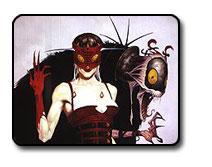Languages
of the Realms
 As
for everything else - sentient races, rulers, gods, and
year-numbering systems - there is a plethora of linguistic
variety in the Realms. There are racial languages and
regional dialects, professional symbols and secret tongues.
There are five "universal" written languages,
and as many differing individual languages as there are
those to speak them.
As
for everything else - sentient races, rulers, gods, and
year-numbering systems - there is a plethora of linguistic
variety in the Realms. There are racial languages and
regional dialects, professional symbols and secret tongues.
There are five "universal" written languages,
and as many differing individual languages as there are
those to speak them.
Most people north and east of the Sea of Fallen Stars
are semiliterate, that is, they know enough of the written
language to get by in their daily lives. The fact that
written language is not universally understood accounts
for many of the specialized sigils and runes within the
Realms, as well as the popularity of bards.
Literacy
is most common among the upper and more professional classes.
It is also assumed to be common among most adventuring
companies, and considered as much a survival skill as
trapping or swimming. Westgate, southern Sembia, and perhaps
Hillsfar in the Heartlands and Waterdeep on the Sword
Coast are predominantly literate areas. Elsewhere one
must "trust to your tongue," as wayfarers say.
In
game terms, the DM may choose to make understanding the
written versions of languages automatic for those who
can speak them - if you can speak common you may read
and write common as well. This is the easiest approach
to language within the Realms, though not particularly
accurate. In reality, reading or writing one of the five
languages should be counted as a separate language proficiency
from speaking the same tongue.
Common
Tongue: Almost all intelligent creatures one might
encounter can understand and speak common (the trade tongue
of humans, spoken with little variance all across the
known Realms), although they may pretend not to. From
region to region of the Realms, common may have different
accents and slightly different vocabularies as it .becomes
influenced by other local human and nonhuman tongues.
While a native of Thay will be able to communicate with
a denizen of Baldur's Gate, each will be aware of the
other's ridiculous accent. In a similar fashion, nonhuman
tongues each belong to the same linguistic tree, so that
elves native to Evereska, Evermeet, and the Elven Court
may understand each other (barring, again, local dialects
and accent). To humans, the elven "common tongue"
is referred to simply as elvish, and the dwarven "common
tongue" as dwarvish. The written common tongue, which
is presented in these writing as English, is a descendent
of Thorass, the original trade language. Most individuals
use runes for conveying information.
Thorass
(Also Called Auld Common): Thorass is the ancient
written trade tongue and universal language of the long-ago
Realms. It is often found in tombs, underground ways,
and ancient habitations and is still in use among the
scribes of the southern noble courts. It is the ancestor
of the common tongue. This language was used primarily
for documents and trading records, as well as histories,
and as such did not achieve common usage. An inscription
in Thorass translates directly into common, although it
usually uses a stilted and archaic form of phrasing and
vocabulary.
Espruar;
This is the moon elven alphabet, in which most elves
of the Realms render messages, either in common or their
native language. A beautiful script alphabet, Espruar
(ES-prue-AR) often covers elven jewelry and monuments
in ornate designs. Espruar is rarely committed to paper,
but when permanent records are required, it is pressed
into metal in the dwarven fashion. Elven histories are
rare, since most of the elves who experienced the historical
events that would be in them are still alive.
Dethek
Runes: Dwarves seldom write on that which can perish.
Rarely, they stamp or inscribe runes on metal sheets and
bind those together to make books, but stone is their
usual medium: stone walls in caverns, stone buildings,
pillars or standing stones - even cairns. Most often,
they write on tablets called runestones in the common
tongue.
A
typical runestone is flat and diamond-shaped, about an
inch thick, and made of granite or some other very hard
rock. The face of the stone is inscribed with Dethek runes
in a ring or spiral around the edge, and the center normally
contains a picture. Some runestones have pictures in relief
and are used as seals or can be pressed into wet mud to
serve as temporary trail markers underground.
To
a dwarf, all runestones bear some sort of message. Most
are covered with Dethek runic script, which translates
directly into dwarvish or common. The runes of this script
are simple and made up of straight lines for ease in cutting
them into stone. No punctuation can be shown in Dethek,
but sentences are usually separated by script slash marks,
words are separated by spaces, and capital letters have
a line drawn above them. Numbers that are enclosed in
boxes are dates, day preceding year by convention. There
are collective symbols or characters for identifying peoples
(clans or tribes) or races. If any runes are painted,
names of beings and places are commonly picked out in
red, while the rest of the text is colored black or left
as unadorned grooves.
Ruathlek:
Ruathlek, the "secret language" or magical script
of illusionists, is rarely found in the Realms. Illusionists
themselves are fairly rare in the North - but Waterdeep
is known to hold at least one library of books in that
dweomer-guarded tongue. It has been surmised that this
written secret language of the illusionists is derived
from the use of magical runes. Illusionists only have
access to this language upon choosing their class. It
may be learned by others, but does not confer the ability
to cast magical spells.
>>Back
to Campaign Background